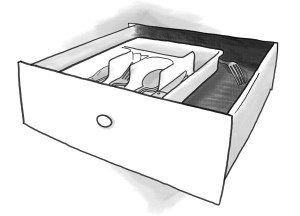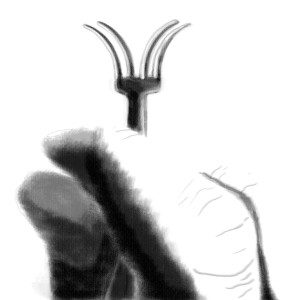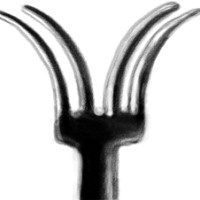My husband, my daughter, and I tolerate a fork in our drawer that doesn’t match the rest of the flatware. Nobody uses it. I never put this fork in the dishwasher. It stays clean. It’s totally lonely, and I don’t know where it came from. Maybe it’s something I had in my house when I lived alone, before getting married, but if so, I didn’t notice it then. It would’ve come in a bag of mixed silverware I bought at a garage sale outside of a historic mansion in one of Portland’s better neighborhoods. Or it might’ve been handed down from my husband’s side of things. I don’t know what silverware he used before we got together.
I grew up in a house of mismatched everything, so that’s not the problem. Still, this fork concerns me. Half the length of the handle is wooden, slender and curved, the curve riding high as a toned yogini’s ass. It’s a dark rosewood, designed to be warmer where it rests against the sensitive stretch of skin between one’s thumb and forefinger; the rest of the fork is stainless steel. There’s an inscribed drawing of curls like a stack of hearts that grow smaller where the steel half of the handle narrows, climbing from the edge of the wooden segment to the head of the fork, the business end of things, and then the hearts are gone. You don’t have to ask Antiques Roadshow to know it’s a relic from the 1970s, a single detail handed down out of a Brady Bunch existence.
I’d call it a divorce-era design.
I’d go so far as to say the metal was forged and tempered through the heat of divorce, the thrill of remarriage. In 1969, Reagan kicked off the “divorce revolution” when he signed the first no-fault divorce law into place, twenty years after he and Jane Wyman split up. Divorce rates doubled immediately. I was a kid then—I saw it happen from that callow place of childhood. And when 1970s parents built new families, they bought new silverware. Classical sets were totally scattered, lost in the rifts.
So now it’s 2013 and a souvenir of that ’70s divorce-era design resides in the dark, shared bed of a slim drawer in our kitchen, in the house of my first and only marriage. When I see that fork—while I hand my daughter a plate of scrambled eggs or hustle dinner to the table—I think: divorce. It’s a tangible symbol, the way a wedding ring symbolizes marriage.
Why does it stay? We don’t use it. We could throw it out, but we haven’t. Is it possible I’m a little fond of it?
***
In the ’70s, I was the middle child in a crowded house. My parents were still married to each other. I had a few close friends and we were big on sleepovers. My family’s house was outside the edge of the suburbs, off the highway. My friends lived inside the ’burbs, on curving roads with cul-de-sacs and sod lawns, and I gravitated their direction. I joined their family dinners, used their new microwaves, trashed sectionals in rumpus rooms, and skinned my knees on orange shag carpet in sunken living rooms. It’s easy to merge into a blended family, where stepsiblings don’t know each other all that well anyway. The houses were full of older stepbrothers, tall hippie-haired boy-men forever just back from the army, or Laos or Cambodia, always with their own rooms hidden in the basements, their floors strewn with Penthouse and Playboy. There were older stepsisters around too, with names like Robyn or Sheryl, usually heading out the door, climbing into the low rumble of a Camaro.
The parents, with mouths to feed, bought slaughtered cows, sides of beef, and packed cut meat into basement freezers. All the innovations were new—chest freezers! bulk beef! pre-packaged pudding!—like everybody was just figuring out how to live. At dinner, we’d sit down to steak with the strangely silent, probably stoned stepbrothers and their looming fathers, with my friends’ mothers, with other daughters, everybody holding sharp steak knives and forks with these sexy wooden handles.
Some of the ’70s parents were swingers, with realistic nude sculptures of couples mating in their bedrooms and economy-sized containers of Vaseline. Sleeping at other people’s houses showed me: there’s more than one way to live. My own parents hadn’t bought a microwave, gotten divorced, or moved into the ’70s much at all yet, other than reading contemporary poetry. When we had steak at home, it was one flank steak judiciously divided.
 Of course we had silverware, and I had no idea where each piece came from. I didn’t think to ask. I was born into that house, that marriage, those dishes. Now I see an inherent question in every drawer of used knives and forks: whose lips have the utensils served, anyway? This is why newlyweds put silverware on the registry: to know where their cutlery has been.
Of course we had silverware, and I had no idea where each piece came from. I didn’t think to ask. I was born into that house, that marriage, those dishes. Now I see an inherent question in every drawer of used knives and forks: whose lips have the utensils served, anyway? This is why newlyweds put silverware on the registry: to know where their cutlery has been.
Growing up, we had a stainless steel spoon in our house with mysterious black markings on the handle that looked intentional as a foreign alphabet, vaguely Japanese. It was designed with an indentation in the bowl area, creased in the center, more interesting than the norm. All three of the kids in my family loved that pseudo-exotic spoon. No other spoon mattered. We wanted to eat Cap’n Crunch with it every day in front of the TV. We’d called dibs on the Japanese spoon, run and crash into the drawer in pile-up.
There was a day in the kitchen when all three of us had a hand on it—my brother, my sister, and me—and we fought in a slow struggle, the way we’d fight if we were each trying to plant our own flag on the moon and we’d all gotten off the same ship, tenaciously elbowing each other out. My sister and I were in nightgowns, my brother in dog-ripped flannel pajamas. We went from one room to the next, over the couch, down onto the grit and dog hair of the braided rug, holding onto the spoon and each other. We rolled over our splintered wooden floorboards down the hall, and pushed our way into the bathroom. The spoon slipped out of our sweaty hands, sailed through the air and came down in an arc. It went in the toilet, where it sank to the bottom and rested against the curve of the toilet’s drain.
The Japanese spoon turned into the toilet spoon. There’s a life lesson: It’s that easy to fall out of favor.
Our mother got the spoon out when she woke up. By then, we all had to pee. We watched her hand dip into the water, into the toilet, where she’d told us never to reach. She washed the spoon, dried it, and put it in the silverware drawer.
Who would use that spoon again, ever?
After that, once in a while a guest, an adult friend of our parents, might unknowingly select that spoon from the drawer, stir sugar into a cup of coffee, and we’d stop whatever we were doing, freeze, and look at each other. Maybe this happened the next day, or ten years later. Time didn’t change anything. That spoon’s reputation was ruined. We’d give the same look now if the toilet spoon were here.
Is it better to tell people a history like that, or not?
***
A closed silverware drawer is a family secret, an orgy of communal history.
 In my mid-twenties, when I counted myself as mostly single, I owned one genuine silver spoon, an otherwise plain spoon that said “Victor Hugo” in block letters on the handle. It was from my garage-sale bag of mixed flatware. I’ve heard there was a time when people traveled in Europe with their own silverware. This was a custom. I believe the spoon in my drawer was Victor Hugo’s personal spoon that had come down to me. It was lacking in ornamentation, the name presented in a utilitarian way. It seemed personal and purposeful. I used it, kept it in the drawer like ordinary silverware, but I loved it more.
In my mid-twenties, when I counted myself as mostly single, I owned one genuine silver spoon, an otherwise plain spoon that said “Victor Hugo” in block letters on the handle. It was from my garage-sale bag of mixed flatware. I’ve heard there was a time when people traveled in Europe with their own silverware. This was a custom. I believe the spoon in my drawer was Victor Hugo’s personal spoon that had come down to me. It was lacking in ornamentation, the name presented in a utilitarian way. It seemed personal and purposeful. I used it, kept it in the drawer like ordinary silverware, but I loved it more.
My boyfriend back then, my manfriend, almost fifteen years older than I was, had pale blue eyes and black curls. He was half-Palestinian, a Wittgenstein expert, and flat-out unemployed, with a Norton motorcycle and a weakness for booze. He was a good time if you like chaos. When I ended our five-year obsessive debauch, when I used all the will of my twenty-five-year-old self to ask him to move on, when he finally moved out of my place, that Victor Hugo spoon disappeared from my drawer. Did he steal it? My Wittgensteinian magpie, maybe he did. I don’t know. These days he lives with his mother in the West Hills area of the same city where I live. We haven’t gone far from each other. I know their phone number by heart, the same number she’s always had, but I haven’t seen either of them in over a decade.
Some day, I’ll call. I’ll ask about Victor Hugo’s spoon. For now, I don’t make the call. I’m married. Victor Hugo’s spoon only exists as an absence in our house, a part of my life I’ve almost let go.
***
Maybe there’s flatware in our drawer from my husband’s former girlfriend—I have no idea—but the breadcrumbs are all ours, and that’s what counts. The divorce fork is cousin to the toilet spoon, friend of the Victor Hugo spoon, each of them a singular piece of silverware, reaching back to my childhood.
My parents divorced in the early ’80s, toward the end of the official “divorce revolution.” My brother and sister went with our mom. Our dad went to work even at night, and I learned one more way to live: as a kid lost in an empty house. Now my daughter is eight, all about songs, books, and love notes: “I love you Mama and Papa!” She’s half the age I was when my mother left.
Some say the threat of divorce keeps a marriage stronger. I hope that’s true. That divorce-era fork exists in our drawer as one option, resting quietly among so many others. I’ve seen my husband’s hand brush over it. He doesn’t know the ramifications. My fingers have grazed the divorce fork too, in our house of easy domesticity.
I let that risky fork sleep next to mated flatware, with a tolerance for freak silverware shaped by my family of origin. Family is built in the details. The fork is a remnant and a reminder: divorce is in reach. So when I wrap my hand instead around the plain, consistent pattern of our discount silverware and forgo the stylized, seductive warmth of a 1970s half-wood handle, it’s an act of everyday devotion. It’s my husband and daughter that I’m holding close.
***
Rumpus original art by Sam Geer.





2 responses
I loved this piece. It’s hard to express the intimacy one feels for the little objects one accumulates in life, the little tokens that mark milestones in our existence, and our hopes and fears for the future, and Monica has done it exceedingly well here. It’s really moved me to think about these little souvenirs that I’ve kept over the years.
My father used to be really into coats of arms. We took a trip to England (where he is from) when I was five, and we came back loaded with spoons and mugs sporting coats of arms, some of which he claimed to be our family coat of arms, despite the fact that in Britain they confer coats of arms on individuals, not families.
Growing up, we had a coat of arms that hung on the wall over the dinner table. When I was little, it seemed very impressive, overpowering even. It legitimized the fish-sticks and casseroles we ate there with the ancient glory of feudalism. As a kid, I never realized just what a tacky piece of crap it was, a plastic knight’s head glued onto a velvet-covered piece of plywood pierced by metal toy swords. At the time, I was immensely proud of it. It was my favorite thing in the house growing up.
My father had grown up in an orphanage, and many years later, after he suffered a debilitating stroke, I learned that his father had been a bigamist, my dad being one of many children from his second family. Maybe the coats of arms were his way of feeling legitimized, of not feeling so unmoored from his family’s past, I don’t know. I do know that when my mom moved out of their house following his stroke, and told me to take anything that I wanted, I chose the old coat of arms that hung over the family table. Bought for a few pounds at a tacky British gift shop in the mid-70’s, it’s now entering it’s second generation of being a personal talisman, a physical connection to my past and his.
Look the hell out Pablo Neruda.
My mom had a pair of these kind of hideous little vases with swirly 60s-looking peacocks on them. They were actually drinking glasses, but thick and ugly, and coated with lead glaze and I was warned not to drink out of them. And definitely not to touch them at all. They came from a trip to Mexico my parents had taken when they were still married, and their loud colors, heaviness, and the word “MEXICO” painted hastily on the bottom made them seem like some Indiana Jonesian relic from an adventurous part of their together-lives I would never know about.
Once I climbed fatly as a six or seven year old up part of a bookcase
where the 2 glasses lived on the top of. There was something else up there that was crystal and shiny that I wanted to look at. It may have been a glass bird. My unskilled climbing rocked the bookcase and the bird took a last flight to the ground where it turned into dangerous glitter. I remember getting thrown over a mother’s shoulder and made to wait in the hall while it got swept up, but I was suddenly more curious about why, standing in the hill of twinkling glass shards, my mother looked up at those MEXICO vaseglasses for a long time.
The two souvenirs from a happier time ended up in a box my mom was delivering to Goodwill a couple of years ago. “Not the MEXICO glassvases! How could you? I shouted. “You can take them,” she said. “I didn’t know you liked them.” I told her the story of the day I killed the crystal diving swan, and how she seemed more interested in the survival of the two glasses than the destruction of the other trinket.
Now, my mother is a champion storyteller, so when she said simply of them, “Your dad and I got these on a trip once,” I knew there was something magic about them. It could have been a last minute purchase, something bought at the beach before packing up the car and returning to a rural Midwestern life. But I like to think that there’s more to them than that, if nothing else, a souvenir of a time when my folks loved each other, when they were full of adventure, and thought nothing of saying screw it and taking a trip to anywhere, before their life stories stopped being written together.
Now those two birdvaseglasses live over the sink in my kitchen, where every morning making coffee, I think of the life I want to live. Full of adventure, travel, and the kind of love with someone that translates only barely into language.
Click here to subscribe today and leave your comment.